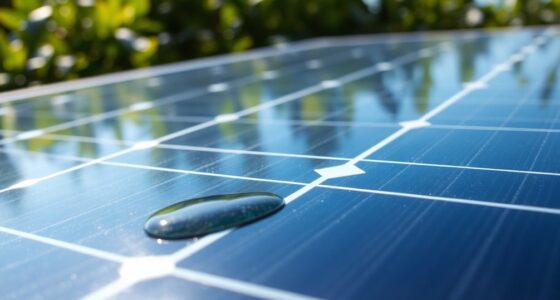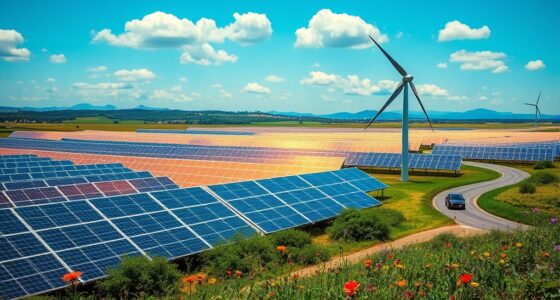Catalytic hydrocracking and isomerization transform Fischer-Tropsch waxes into high-quality transport fuels. These processes combine cracking and hydrogenation to produce lighter, valuable fuels like diesel and naphtha while improving fuel properties. You'll find that catalyst selection, temperatures, and reaction conditions are crucial for maximizing yield and quality. As you explore further, you'll uncover insights into how these methods enhance emissions profiles and meet stringent fuel specifications.
Key Takeaways
- Catalytic hydrocracking effectively transforms Fischer-Tropsch waxes into valuable transport fuels like diesel and jet fuel through a two-stage process.
- Zeolite-based catalysts, particularly beta zeolite, enhance isomerization by improving the conversion of straight-chain alkanes into branched isomers for better fuel properties.
- Optimal reaction conditions, including high temperatures and pressures, are crucial for maximizing product yield and quality in hydrocracking processes.
- The incorporation of metal components like nickel and tungsten in catalysts boosts hydrocracking activity and improves the overall efficiency of the process.
- Proper catalyst selection and balanced reaction times are essential to prevent excessive cracking while ensuring high cetane numbers in the final fuel products.

When you think about refining heavy hydrocarbons into valuable fuels, catalytic hydrocracking and isomerization play crucial roles. Hydrocracking's two-stage process combines catalytic cracking and hydrogenation, converting heavy hydrocarbons into lighter products like diesel and naphtha.
Catalytic hydrocracking and isomerization are essential for transforming heavy hydrocarbons into valuable fuels like diesel and naphtha.
You'll find isomerization particularly important for transforming straight-chain alkanes into branched isomers, enhancing fuel properties such as pour point and smoke point. The process enhances diesel cetane number, which reduces emissions and improves cold flow characteristics of fuels.
The effectiveness of both processes hinges on catalyst selection. Zeolite-based catalysts are popular due to their shape selectivity and acidity, which facilitate the necessary reactions. Incorporating metal components like nickel, tungsten, and molybdenum into hydrocracking catalysts boosts activity, making them more efficient.
If you're dealing with Fischer-Tropsch waxes, phonolite-supported catalysts can effectively co-process these waxes alongside vacuum gas oil, leading to better product quality.
You'll need to pay attention to the feedstock composition, as a higher wax content can significantly improve the outcome of hydrocracking. Reaction conditions are also vital. Hydrocracking typically operates at high temperatures (750°-1,500° F) and pressures (1,000-2,000 psi), with hydrogen playing a critical role in preventing coke formation and converting sulfur and nitrogen compounds.
Adjusting space velocity and hydrogen circulation rate can further influence reaction severity and product yield.
Isomerization selectivity is affected by the zeolite structure, with beta zeolite being particularly effective. Reaction time impacts product conversion, so you'll need to balance longer times to avoid excessive cracking.
After hydrocracking, you'll primarily produce middle distillates like diesel and jet fuel, characterized by high cetane numbers that enhance emissions and fuel quality.
Frequently Asked Questions
What Are Fischer-Tropsch Waxes and Their Significance in Fuel Production?
Fischer-Tropsch waxes are synthetic paraffin waxes produced through the Fischer-Tropsch process, involving carbon monoxide and hydrogen.
They're significant in fuel production due to their high molecular weight and chemical purity, making them ideal feedstocks for high-quality transport fuels.
When you upgrade these waxes, you get cleaner-burning fuels with low sulfur content, enhancing environmental benefits.
Their stability and versatility also open doors for various industrial applications beyond just fuels.
How Do Catalytic Hydrocracking and Isomerization Differ in Process and Outcomes?
When you compare catalytic hydrocracking and isomerization, you see two distinct processes at work.
Hydrocracking breaks down larger hydrocarbons into lighter products, requiring higher temperatures and pressures, while isomerization rearranges molecules to enhance fuel properties without altering carbon numbers.
The outcomes differ too: hydrocracking yields cleaner, uniform fuels, while isomerization improves cold flow characteristics.
Understanding these differences helps you appreciate how each method contributes uniquely to fuel production.
What Catalysts Are Commonly Used in Hydrocracking and Isomerization Processes?
In hydrocracking and isomerization processes, you'll commonly encounter bifunctional catalysts that combine metal and acid sites.
Noble metals like platinum and palladium are favored for their selectivity, while non-noble metals like cobalt and nickel are also utilized.
Zeolite-based catalysts, such as beta and ZSM-5, enhance activity due to their pore structure and acidity.
These catalysts play a crucial role in optimizing reaction conditions and achieving desired product distributions.
What Are the Environmental Impacts of Upgrading Fischer-Tropsch Waxes?
Upgrading Fischer-Tropsch waxes is like polishing a diamond; it reveals both beauty and challenges.
You'll notice significant environmental impacts, such as reduced emissions and improved fuel quality. While these processes enhance combustion properties, they can also raise production costs.
The choice of feedstock plays a crucial role in emissions, and adopting clean technologies is essential. By optimizing processes, you can help create a cleaner, more efficient energy landscape for the future.
How Does the Quality of Transport Fuels Compare Before and After Upgrading?
When you compare the quality of transport fuels before and after upgrading, you'll notice significant improvements.
Before upgrading, fuels often have high emissions, low cetane numbers, and undesirable properties.
However, after the upgrading process, you'll see high cetane numbers, reduced emissions, and cleaner combustion characteristics.
The upgraded fuels also contain low aromatics and sulfur, making them more environmentally friendly and suitable for various conditions, enhancing overall performance and efficiency in transport applications.
Conclusion
In summary, catalytic hydrocracking and isomerization are game-changers for upgrading Fischer-Tropsch waxes into high-quality transport fuels. By harnessing these advanced techniques, you can unlock the potential of waxes, transforming them into fuels that are as efficient as rocket fuel. This not only enhances energy output but also supports a cleaner environment. Embracing these processes means stepping into a future where waste is minimized, and sustainable energy solutions reign supreme. The road ahead is bright and full of possibilities!









